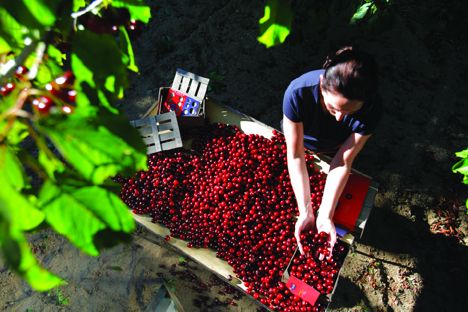
Picota cherries: the red diamonds of Spain
Cherries of any kind are delicious when in season, but for a real treat seek out the PDO-protected Picota del Jerte, a teardrop-shaped fruit that’s remarkably sweet. Learn about their history, why they’re so special and the best ways to cook with them.
Picota cherries: the red diamonds of Spain
Cherries of any kind are delicious when in season, but for a real treat seek out the PDO-protected Picota del Jerte, a teardrop-shaped fruit that’s remarkably sweet. Learn about their history, why they’re so special and the best ways to cook with them.
In the Jerte Valley in Extremadura – a region of Spain between Madrid and the Portuguese border – there’s one time of year where a million trees swell with tiny red fruit. These little cherries are only available from June to the end of July, but they’re some of the best in the world – so much so that they have Protected Designation of Origin (PDO) status. They are Picota cherries, and if you see some for sale, be sure to snap them up.
Cherries have been grown in the Jerte Valley for centuries, but since the 1960s they’ve become a tourism attraction in their own right. Much like the sakura cherry blossom in Japan, Picota cherry trees blanket the valley in white petals, creating a stunning scene that attracts people from across Europe. The two-week festival sees the normally quiet and sleepy region turn into a celebration of nature, Spanish food and drink and, of course, cherries.
Only 13,000 people live in the Jerte Valley, and around 5,000 of them are involved with the Picota cherry industry, so it’s an incredibly important part of daily life in the region. But what makes them so special? The first thing you’ll notice is they’re sold without stalks as the cherries are left to ripen fully before being picked by hand, which means the stalks drop off during the harvest. The second thing you’ll notice is the unique shape of the fruit itself – unlike other cherries which are round, these ones come to a natural point, hence the name Picota (pico is Spanish for peak, or point). And when you taste the cherries, it’s impossible to ignore the incredibly intense, sweet flavour. This is thanks to how the cherries are grown; they are left to mature for twice as long as usual, basking in the Spanish sun which allows the fruit to develop its flavour and colour.
There are actually four varieties of Picota cherry grown in the Jerte Valley. Ambrunés are generally regarded as the most prized cherry variety (and makes up most of production), while pico negro have a striking dark crimson colour. The flesh of a pico limón negro cherry is almost black, and pico colorado is particularly hardy and lasts longer than other varieties.
Half of all Picota cherries are exported out of Spain into other countries across Europe – the UK included. But be quick – they’re only available for six weeks of the year, beginning in the middle of June – after that, you’ll have to make do with any jams, preserves or liqueurs made from the fruit. Once you’ve got some it’s tempting to just eat them all as they are (and do try at least a few on their own to fully appreciate their fresh flavour and extra-juicy texture), but if you set some aside for cooking you’ll be able to create some truly delicious dishes. Try using them in Paul A Young’s Cherry chocolate cooler for the ultimate summertime drink, or bake them into a muffin or clafoutis for a very special teatime treat.
Cherries always go well with chocolate, and because Picota cherries are particularly sweet, they pair beautifully with dark, rich chocolate – try using them in Rosana McPhee’s Chocolate nut torte with cherry meringue ice cream or Claire Clark’s Rocky road cheesecake. Picota cherries work in a savoury context, too – particularly rich, fatty meats like duck. Paul Welburn’s Roast duck breast and crispy leg croquettes with cherries and almonds would be an ideal dish to use your special cherries in, as would Steven Smith’s Octopus, lobster and scallop wontons with cherries and pink fir potatoes.
Whatever you end up doing with your Picota cherries, make sure you appreciate just how much hard work goes into their production (they are hand-picked, after all) and remember that they’re available for just six weeks of the year – the perfect example of seasonal produce.

